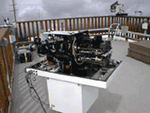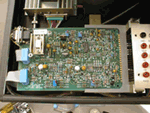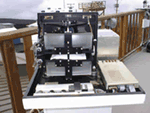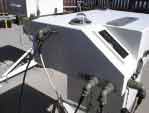More than two years after road access and electrical power to the Mauna Loa Observatory was cut off by lava flows, NOAA staff continue to make critical measurements of the atmosphere and other environmental variables at the remote site.
In 2023, observatory staff installed solar panels at the site and resumed some measurements, including the independent carbon dioxide monitoring programs run by the Global Monitoring Laboratory and Scripps Institution of Oceanography, as well as other atmospheric measurements.
Construction of a temporary road to access the observatory site is anticipated to begin in summer 2025.
Media can contact: Theo Stein (303) 819-7409 (theo.stein@noaa.gov)
Organization(s):
 Network For the
Detection of Atmospheric Composition Change (NDACC)
Network For the
Detection of Atmospheric Composition Change (NDACC) Meteorological Service of Canada (MSC)
Meteorological Service of Canada (MSC)
What does this program measure?
Two Brewer ozone / ultraviolet spectrophotometers operate continuously outdoors at MLO. The systems are controlled by desk-top computers located inside the MLO NDSC building. Spectral scans of global UV-B irradiance are made approximately three times each hour during daylight hours. The MKIII Brewer makes measurements at 0.5 nm intervals at wavelengths between 286.5 nm and 363.0 nm with a resolution of about 0.5 nm. The MKIV Brewer makes the same measurements between 290.0 nm and 325.0 nm. Direct sun total ozone measurements are made up to 80 times per day, depending on the time of year.
Total ozone is measured in Dobson Units, Total sulfur dioxide (SO2) in DU, and Global UV-B Radiation and extraterrestrial spectra are measured in mWatts/m^2
How does this program work?
The technique used is absorption spectroscopy of ultraviolet radiation. The Brewer ozone / ultraviolet spectrophotometer operates continuously outdoors. A sky camera is installed in the lid of the MKIV Brewer and captures a sky image every ten minutes. The Brewers and the sky camera are controlled by indoor desk-top computers with cables (100 ft.). The Brewers are visited by Meteorological Service of Canada (MSC) staff on a two-year cycle for calibration, maintenance, repairs and system upgrades.
Please note that more information is available for this project in a publication at this link....
Why is this research important?
The data will provide useful long term measurements of ozone and UV-B at the Mauna Loa site and would be available for comparison with other measurements at the NDSC site (lidar, etc.,). This research is also part of maintaining the Brewer reference in Toronto. The CURVI will also enhance the periodic extraterrestrial calibrations that MSC carries out at MLO.
Are there any trends in the data?
No significant trends observed to date.
How does this program fit into the big picture?
What is it's role in global climate change?
MSC Brewer (courtesy of Forrest M. Mims III)
Stratospheric ozone affects climate change and is also affected by climate change through its radiative and dynamic interactions. Ultraviolet-B (UVB) radiation can be influenced by climate change.
Comments and References
Kerr, J.B., New Methodology for deriving total ozone and other atmospheric variables from Brewer spectrophotometer direct sun spectra, J. Geophys. Res., 107, doi:10.1029/2001JD001227, 2002.
For more information, please reference publication using this link....
Lead Investigator(s):
Tom Grajnar
Network Manager
416-739-4633
Michael Brohart
Network Technologist
416-739-5735
MLO Contact(s):
Nash Kobayshi
808-933-6965 (x230)
Paul Fukumura
808-933-6965 (x223)
Web Site(s)
http://exp-studies.tor.ec.gc.ca/e/ozone/ozonecanada.htm
Date Started
1997





